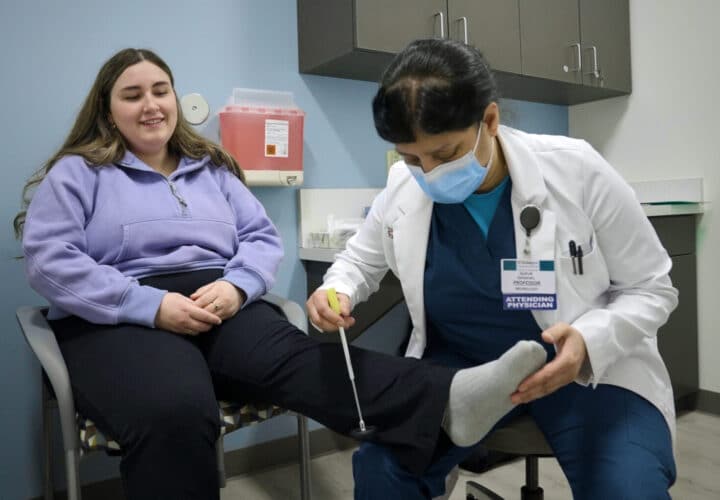A new clinical trial for Eli Lilly's experimental anti-amyloid remternetug is aiming to change the fate of people with familial Alzheimer's.
There currently no cure or treatment that can completely halt or reverse Alzheimer’s pathology in the brain. One of the biggest obstacles: Even after more than a century of study, scientists still aren’t exactly sure what causes this disease. But many drug developers have put years of research — and billions of dollars — into one particular theory: the controversial, but leading, “amyloid hypothesis”: that naturally occurring beta-amyloid proteins one day go haywire, start clumping up in the brain, and cause Alzheimer’s disease, all on their own. Certainly, beta-amyloid does build up in the brains of people with Alzheimer’s and related neurodegenerative diseases. But, is this Alzheimer’s disease’s cause? So far, scientists can say one thing for certain: It’s complicated — very complicated.
A couple drugs, in recent years, have shed a bit more light on amyloid’s role in Alzheimer’s, receiving full approval from the FDA. These “anti-amyloid” drugs help clear amyloid out of the brain, and have been shown to have a very small positive effect in slowing down symptoms progression for people in the earliest stages of Alzheimer’s. Eli Lilly has been trialing another experimental anti-amyloid — remternetug — for the past few years. In a new clinical trial, they’ve decided to take a different approach: starting way, way earlier.
The Phase 2/3 clinical study is enrolling participants as young as 18, who have Alzheimer’s in their families, and who are — based on their relatives’ experience with Alzheimer’s — at least a decade out from developing it.
“Most of the people that will start this study won’t have any amyloid in their brain that we can detect,” Dr. Eric McDade, a professor of neurology at Washington University and the lead investigator of the trial told Endpoints. “We’re calling it ‘Primary Prevention.’”
Hannah Richardson is just 24 years old — but she has been aware of Alzheimer’s for a long time. Her grandfather passed away of Alzheimer’s, as did her grandfather’s mother and all but one of his siblings. Her own mother and her uncle have been participating in Alzheimer’s clinical research for more than a decade.
“I knew immediately I wanted to be a part of it,” she said of the new prevention trial. “I hope there is benefit. But even if that is not the outcome, just collecting this data is still so important for helping people down the line not suffer the way that people are suffering now.”
It’s an exciting new approach to drug trials, experts are saying “This is really going to be a landmark study,” Howard Fillit, chief science officer of the Alzheimer’s Drug Discovery Foundation, told Enpoints. “I believe it is the earliest treatment trial that has ever been conducted.”
Recruiting for Primary Prevention
The Primary Prevention Trial is focused on people who carry rare genetic mutations that all but guarantee they will develop early-onset Alzheimer’s. Many of the people who carry these genes — APP, PSEN1, and PSEN2 — begin showing symptoms in their 30s or 40s.
It’ll enroll roughly 240 young adults around the world, aged 18 to early 30s who have family member who has APP, PSEN1, or PSEN2.
Because children who inherit these genes tend to show signs of dementia around the same age their parents did, the trial administrators are recruiting people who are about 11 to 25 years younger than the age their family member(s) started to show symptoms.
Considering Genetic Testing for Alzheimer’s? 3 Things to Know
What is remternetug and how does it work?
Remternetug is an investigational monoclonal antibody developed by Eli Lilly. It belongs to the same class of drugs as donanemab (marketed as Kisunla), an injection-based drug approved by the FDA in July 2024 for people in the very earliest stages of Alzheimer’s.
Like donanemab, remternetug targets beta-amyloid, a protein that misfolds and accumulates in the brain, forming plaques that are strongly linked to the progression of Alzheimer’s. It’s designed to clear these plaques from the brain, or prevent them from forming altogether.
Amyloid pathology can be identified in the brain as much as 20 years before cognitive symptoms ever appear, so, by intervening early, the researchers hope to prevent the quiet cascade of brain changes that eventually lead to those symptoms.
McDade said there’s been tremendous progress in Alzheimer’s treatment in just the past two years, with the full FDA approvals of anti-amyloid drugs Kisunla and Leqembi, on the basis that these drugs can slow anti-amyloid plaque build-up in the brains of people with mild cognitive impairment or mild dementia due to Alzheimer’s.
“This provides strong support for our hypothesis that intervening when amyloid beta plaques are at the very earliest stage, long before symptoms arise, could prevent symptoms from emerging in the first place,” he said in a statement.
In a possible advantage over its two FDA-approved predecessors, remternetug offers a more spaced-out administration schedule, with quarterly injections instead of monthly infusions, making it potentially more accessible and, so, more practical for long-term treatment.
How does the trial work?
The trial is a Phase 2/3 multi-center, randomized, double-blind, placebo-controlled study. Each participant will undergo treatment with remternetug injections (or a placebo) every three months, for two years. Participants who carry the Alzheimer’s-linked mutations APP, PSEN1, or PSEN2 will be compared against any of their relatives who didn’t inherit these gene mutations. These non-carriers will serve as a control group.
After these first two years, people with the genetic mutation will have the option to continue taking the drug for an additional four years in an open-label trial extension.
One of the biggest challenges of the study is its duration. Because Alzheimer’s develops so slowly, it could take decades to know definitively whether remternetug actually does prevent the disease. That said, the researchers believe they can gather meaningful data within the first five years, by checking in with the patients and monitoring beta-amyloid build-up in the brain.
What’s next for the prevention trial?
McDade expects to report the results of the trial within the next four to five years, depending on how long it takes to meet enrollment goals. Results from the first phase could be available as early as 2027. Trial administrators expect the study overall to be completed by 2034.
All in all, it’s expected to cost more $130 million, with more than $98 million coming from the National Institutes of Health, and other funding coming from WashU, Joanne Knight of St. Louis and family, and Eli Lilly, and other donors.
It’s part of the Dominantly Inherited Alzheimer Network Trials Unit (DIAN-TU), a research initiative tracking families with genetic mutations that cause early-onset Alzheimer’s.
More than $130 million has been earmarked for the effort, including grants totaling an estimated $98.3 million from the NIH’s National Institute on Aging (a long-time funder of DIAN) and $14 million from the Alzheimer’s Association and the GHR Foundation.
Feature image: Primary Prevention trial participant Hannah Richardson, 24, undergoes a clinical exam given by WashU Medicine neurologist Nupur Ghoshal, MD, PhD. The international trial, led by WashU Medicine, aims to determine whether stopping the early molecular changes that lead to symptomatic Alzheimer’s disease can prevent the disease from ever taking hold. Photo courtesy of WashU.




